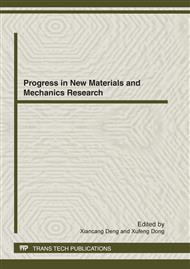p.277
p.282
p.287
p.292
p.297
p.302
p.306
p.312
p.316
Mechanical Property and Conductivity of Polyaniline-Poly(Vinyl Alcohol)Composite Films
Abstract:
The polyaniline(PANI)-poly(vinyl alcoho1)(PVA) composite films with the doping of hydrochloride (HCl), dodecylbenzenesulfonic acid (DBSA) or aminosulfonic acid (NH2SO3H ) were prepared by in-situ polymerization. Effects of PVA content, HC1 content, oxidant ammonium persulfate(APS)dosage, reaction time and film drying temperature on tensile strength of the HCl-PANI-PVA composite film were studied. The conductivity of PANI-PVA composite film with the doping of HCl is the highest of 13.2S.cm-1 among them. The tensile strength of the film is improved greatly due to effective mixture of PANI and PVA. The tensile strength of the composite film substantially depended upon the mass fraction of PVA. The tensile strength of the HC1-PANI-PVA composite film reaches the maximum of 60.8 MPa, in case the PVA content is 40%, the C(HC1)=1.0 mol/L,reaction time is 4.0 h, the n(APS/An)=1.0, and film drying temperature is 80°C.
Info:
Periodical:
Pages:
297-301
Citation:
Online since:
April 2012
Authors:
Keywords:
Price:
Сopyright:
© 2012 Trans Tech Publications Ltd. All Rights Reserved
Share:
Citation:


